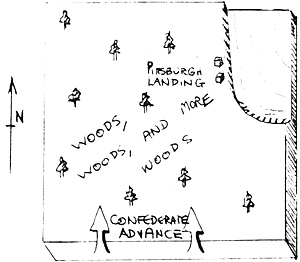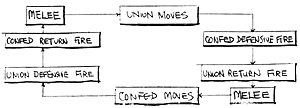INTRODUCTION
Ten of us gathered at Rich Hasenauer's house to refight the battle of Shiloh using Mike Pierce's and Rich's latest American Civil War effort: THE FOG OF WAR (TFOW). TFOW was supposed to be called THIS HALLOWED GROUND; somebody beat the boys to use of this by a month or so... and TFOW is the fallback position.
I should note that, after I authored this report and handed it to Rich and Mike for comment, I was told that THE FOG'OF WAR had bitten the dust; it lay, unmoving, alongside THIS HALLOWED GROUND.
But if not THIS HALLOWED GROUND, and if not THE FOG OF WAR, then... what? I have since been informed by Rich that the final name for the rules - the very FINAL name - is a close kept secret, not to be released until the rules are published. And even then, it appears, wargamers will only whisper it around the table, not daring to say it aloud.
I'm beginning to see the logic in a suggestion set forth by Leo Cronin, who said to forget about these "box office" names; instead we should have Cronin's ACW Rules, and Hasenauer's ACW Rules, and Bowden's ACW Rules, and Simon's ACW Rules, and so on. Rules is rules... but I digress.
For the remainder of this article, not knowing any better, and until otherwise advised, I shall refer to Hasenauer's ACW Rules as THE FOG OF WAR (TFOW).
THE SET-UP
Shiloh, fought in April, 1862, was a bloody. grinding battle of two pretty-much-equal forces fought on very wooded terrain. TFOW, using 15mm figures, produced a bloody, grinding battle between two pretty-much-equal forces fought on very wooded terrain. Rich was quite happy with the result... this, he said, is an excellent simulation of what actually happened.
For my part, I'm not sure what a simulation is any more, for I can thumb through my wargame library and easily pick out more than a dozen or so ACW sets that will produce a bloody, grinding battle when two pretty-much-equal forces fight on very wooded terrain. And if you don't like the published rules, then within ten minutes, I can write an ACW set resulting in a bloody, grinding battle when ...etc., etc. Are these ALL "simulations"? Ah dunno...
The important factor to me was that TFOW produced an interesting battle, extremely enjoyable despite the slow moving, steady, heavy slogging going on.
Above all, Rich is an artist, and he outdid himself with Shiloh: every detail on the map was reproduced in 3-D on the 6x8 table, and he backed up the battle with a very unique rules booklet complete with charts and pictures. Assuming Rich and Mike intend to publish TFOW, I will try not to steal their thunder, but give a general description of the Shiloh encounter.
TFOW's scales are similar to that of ON TO RICHMOND; one inch is 50 yards and brigades vary from 8 to 11 stands each. The brigade, not the regiment, is the basic maneuver element.
 THE BATTLE
THE BATTLE
In broad-brush fashion, the Shiloh scenario is depicted on the map. It is 0530 on April 6, 1862, and the Confederates are about to launch an attack from the south on the unsuspecting Union encampment. Yankee soldiers are spread out all over the map, the brigades in each division carefully separated so that they are out of sight of each other, and all Yankee troops are comfortably asleep. Onto the board sneak the Rebel troops and the fun begins.
The Confederate advance is aided by the following:
- a. Yankee troops in the separate brigades will not "awaken" until a courier from their division commander arrives at brigade headquarters.
b. Having awakened, however, there's still only a 50% chance that the sleepy fellas start to form up.
c. It's only on Turn 6 that all Yanks are deemed to have arisen and can get going.
Item (a) above is critical and each division general is assigned a number of command points by means of which he alerts and directs his brigades. Naturally, there are not enough points to alert everyone at once, and there's a certain amount of inertia involved before all the Union troops start marching out.
An excellent balance was achieved by the scenario designers in the plusses and minuses of gathering the Yankee troops, for the first lines of defense formed just where the first lines of defense should have formed, and reinforcements came in like clockwork.
We played thirteen turns, each turn equivalent to 20 minutes battle time. The unfortunate thing was that in nine of the 13 same turns, the game time to play out the turn exceeded the 20 minute battle time. This is not really a fair criticism, for in skirmish gaming, as an example, a one minute event (running forward and firing) can take ten minutes to resolve.
 The turn sequence is diagrammed in simplified fashion. Note that there are four fire phases per turn... two for each side. Coupled with the two melee phases, the turn length can drag on... 13 turns took seven hours to play. And when we all quit, exhausted, at the end of 13 turns at 2:40 AM, there was still a lot of discussion on what the outcome eventually would be.
The turn sequence is diagrammed in simplified fashion. Note that there are four fire phases per turn... two for each side. Coupled with the two melee phases, the turn length can drag on... 13 turns took seven hours to play. And when we all quit, exhausted, at the end of 13 turns at 2:40 AM, there was still a lot of discussion on what the outcome eventually would be.
One negative factor... negative in my eyes... is that the sequence permits an oncoming attacker as many opportunities to fire as a non-moving, dug-in defender. I prefer sequences in which a defensive player gets more "fires",than the moving offensive side.
Mike Pierce's comment: I agree - but - the defender's first fire has the effect of denying the attacking player some of his "fires" because of morale results - also, defensive fire disorders attackers and may "kill" stands.
TFOW removes stands when casualties are taken; despite this, TFOW is a "morale game"... there are very few routs, there are lots of instances wherein units are temporarily thrown back and disorganized, but there are almost as many instances of units immediately recovering and bouncing back into combat.
I like morale games and the "elastic units" they produce. For the refight of Shiloh, the "get thrown back and immediately spring back" procedure was essential, for if every unit that got repulsed was deemed broken, and had to wait several turns to recover, the game would have lasted two turns.
Due to the scale, the 20-minute turn, and the use of 15mm figures, movement rates for TFOW provide a fairly flowing game if played in open terrain: infantry in line move 10 inches, cavalry 15 inches. The wooded Shiloh terrain, however, halved these distances, and on a 6 foot by 8 foot table, 5 inch movements for infantry resulted in a fairly static front line... similar to the old WRG ancients battles in which one could drift away and come back to table-side every 30 minutes and see no apparent movement at all.
Forward movement on the part of the advancing Confederate troops was even more slowed down by the fact that, as they came into contact with the defending Yanks, the most predominant melee result seemed to be "retreat in disorder beyond musket range". In the thick woods, musket range was reduced to two inches (100 yards), and defeated Union units thus fell back 2 1/2 inches.
What this meant was that a Rebel unit, even if it won a melee, ,on its next 5-inch move forward, had to hit the same defeated Yankee unit which it had just pushed back 2 1/2 inches. Movement in many cases was thus effectively reduced to a series of 2 1/2 inch moves.
Mike Pierce's comment: The charge test produced this retreat result, however, when a unit is disordered, it must rally, and a unit that doesn't rally may break and run far away. This rallying mechanism produced most of the large scale "running away".
Rich Hasenauer's comment was to the effect that he and Mike are trying to speed up the game. He didn't elaborate as to the "hows", however... I
CONCLUDING COMMENTS
"But this is the way it happened at Shiloh", repeated Rich during a post-game discussion on the advisability of presenting the scenario at an HMGS convention. After a while, however, I thought his audience persuaded him that Shiloh or no Shiloh, there simply wasn't enough action to present to a hyperactive, screaming crowd of bloodthirsty wargamers.
As an advocate of card sequences, I like the system of brigade movement used in ON TO RICHMOND. On the other, hand, I like the TFOW sequence in which a moving unit must take enemy fire before replying with its own.
TFOW's command/control point system, wherein each commander is graded by having only so many points to do so many things, seems to be taken up by more and more rules sets these days. Jim Arnold's GENERALSHIP rules use this ploy, and even WRG 7th came of age by including a provision which places a cap on the number of charges-to-contact a commander can order.
One thing I didn't like... and this seems to be common to all games I've seen which employ 15mm figures... is the 3-man-per-stand mounting system. Three dinky figures on a dinky three-quarter inch stand look dinky to me.
On the table, when three to six brigades were at close quarters and mixing it up, the panorama was fine... a birdseye view of lots of blues and grays interiiiixed and fighting it out. But once the brigades were separated and the individual stands could be spotted, dinkiness returned once again.
Sometime ago, our group bought a slew of 15m Napoleonic figures and, in an effort to achieve visual "mass", mounted them six to a stand. I have regretted this ever since... six is still in the dinky league ... and it appears that 10 to 12 figures per stand would just about do it.
But all this aside, TFOW ain't bad atall. If Rich and Mike find a fast moving scenario by means of which they can present their effort at a convention, they may offer ON TO RICHMOND some competition.
But wait: A Biggum Post Scriptum...a late note to this epic.
It seems that Rich, despite the advice of his Military Staff, despite the dire forebodings of his Security Council, and despite the input of his Joint Chiefs, chose, after all, to present the Shiloh scenario at the HMGS convention. Twice, did he do it!
And, of course, it was a vast success.
But we knew that all the time, Rich... just trying to keep you on your toes, lad...
Back to PW Review April 1987 Table of Contents
Back to PW Review List of Issues
Back to MagWeb Master Magazine List
© Copyright 1987 Wally Simon
This article appears in MagWeb (Magazine Web) on the Internet World Wide Web.
Other military history articles and gaming articles are available at http://www.magweb.com